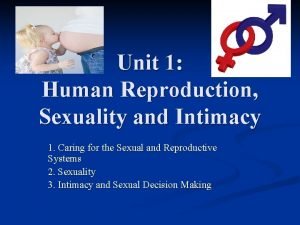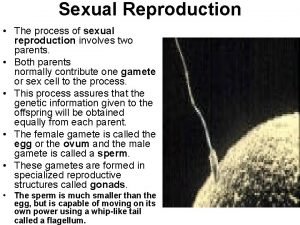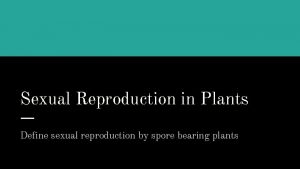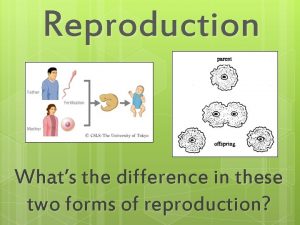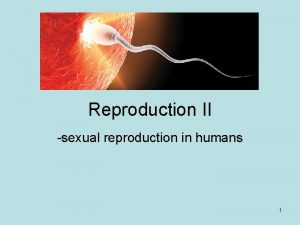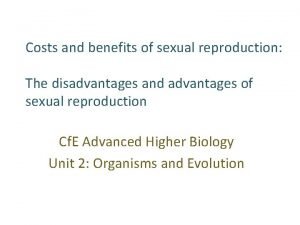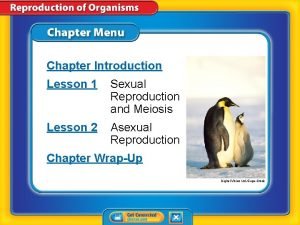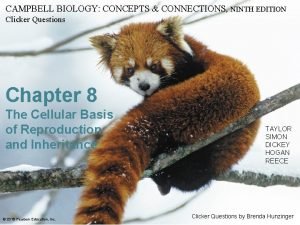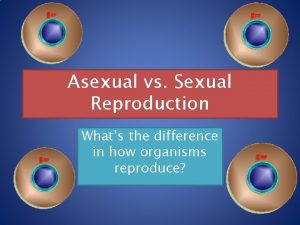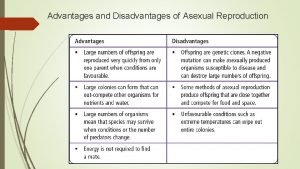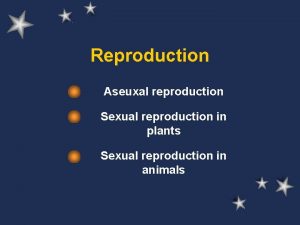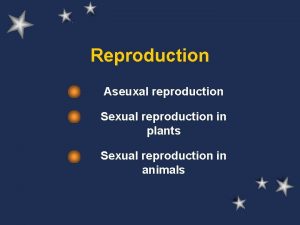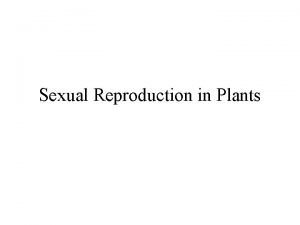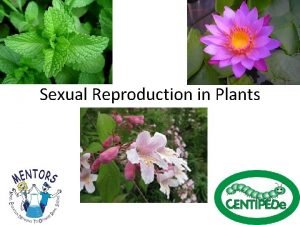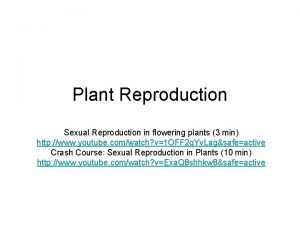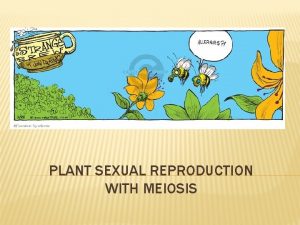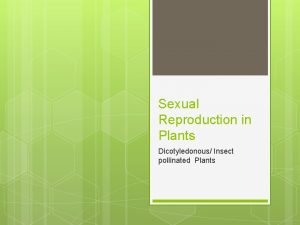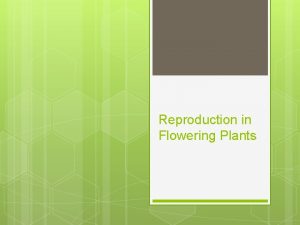Plant reproduction Reproduction in plants Sexual reproduction Formation



















- Slides: 19

Plant reproduction

Reproduction in plants Sexual reproduction Formation of gametophyte (male or female plant or a single plant with male and female parts) Asexual reproduction Formation of sporophyte (plant makes spores which are asexual reproductive cells)

Recall. . Carpel = female reproductive floral part, comprising a stigma, style, ovary, and ovule Stigma = sticky surface on top of the style Style = tube like stalk that leads to the ovary Ovary = contains one or more ovules each of which forms a seed when it is fertilized

Flower Parts • Not all flowers have every part… Stamen = male reproductive floral part, comprising of an anther and a filament Anther = floral organ that produces pollen Filament = thin stalk that supports the anther (raises the anther above the female organ)

Sexual Reproduction in Angiosperms (seed plants) Flowers = key organs in sexual reproduction of angiosperms

Mechanisms of sexual reproductionpollination Cross-pollination – transfer of pollen grains from one plant to another – Example: Most plants • Self-pollination – transfer of pollen from one flower to another on the same plant – Example: Wheat, peas

Pollinators Help with the process of pollination of the plant. Examples of pollinators are: • Insects: bees, wasps, etc. • Animals: cows, sheep, etc • Wind


Seed Plants (Angiosperms) undergo Sexual Reproduction • Meeting (fertilization) of two haploid cells (sperm + egg) • Fruit= mature ovary inside seed plants (angiosperms) o Inside fruit seeds o Resulting embryo from fertilization grows in the seed

Function of seeds: § Carry the embryo to a new location (this means that the resulting new plant is introduced to new area) § Protects and nourishes the embryo (the seed is also a store for food)

Benefits of Sexual Reproduction • high level of genetic diversity • seeds dispersed – may have less competition for resources • seeds can remain dormant for long periods of time – germinate when conditions are favourable

Costs of Sexual Reproduction • requires specialized structures and cells that are devoted entirely to reproduction • which takes up a lot of resources • during times of scarcity sexual reproduction can lower the chances of survival

Examples of sexually reproducing flowers Daffodils Evening Primrose Golden Rod

Asexual Reproduction in Seed Plants • a single parent produces offspring by cell division • mitosis of diploid cells genetically identical individuals • Example: take a stem cutting and place it in water – get more plants

Reproduction in plants Sexual reproduction Formation of gametophyte (male or female plant or a single plant with male and female parts) Asexual reproduction Formation of sporophyte (plant makes spores which are asexual reproductive cells)


Reproduction in non-seed plants • Non-seed plants also undergo asexual reproduction Examples: Mosses Ferns

Benefits of Asexual Reproduction • if plant has a beneficial trait that allows it to survive then all offspring will have the same trait • no need for specialized reproductive structures (faster reproduction) • only need one plant • produce more robust offspring = higher survival rate

Costs of Asexual Reproduction • lack of genetic diversity! • If the environment changes drastically the population may not have enough genetically diverse individuals to survive the change • = extinction
 A sexual reproduction in plants
A sexual reproduction in plants Binary fission in bacteria
Binary fission in bacteria Hare lynx
Hare lynx Asexual reproduction vs sexual reproduction venn diagram
Asexual reproduction vs sexual reproduction venn diagram A sexual reproduction in humans
A sexual reproduction in humans Sexual reproduction
Sexual reproduction Sexual reproduction?
Sexual reproduction? Define sexual reproduction
Define sexual reproduction Section 1 meiosis
Section 1 meiosis Whats sexual reproduction
Whats sexual reproduction A sexual reproduction in humans
A sexual reproduction in humans Chapter 10 sexual reproduction and genetics
Chapter 10 sexual reproduction and genetics Sexual or asexual reproduction
Sexual or asexual reproduction Connecting the concepts sexual reproduction
Connecting the concepts sexual reproduction Chapter 10 section 3 gene linkage and polyploidy
Chapter 10 section 3 gene linkage and polyploidy Is mitosis asexual
Is mitosis asexual Biology
Biology Whats asexual reproduction
Whats asexual reproduction Examples for sexual reproduction
Examples for sexual reproduction Disadvantages of sexual reproduction
Disadvantages of sexual reproduction




